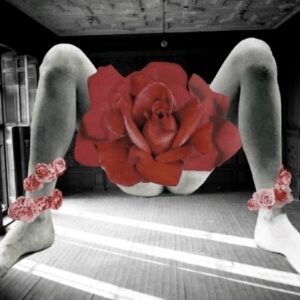In the Art
By Lilian Dabat
We are walking inside a painting; the light is red like a sunset. To our right, we see an elephant with long legs. We are in the middle of the desert, feel its heat, and see the sand on the ground. But this is not reality, it is not a dream either It’s something else. We feel it on our skin, we feel emotions as if this work was alive as if we were inside, yet we are not. This is, of course, immersive art. Find more about why immersive art is a kind of revolution here In the Art
It is no new phenomenon. It has been used since the Middle Ages, notably with the creation of illustrated and coloured stained glass windows in churches to tell religious stories.
In the 18th century, phantasmagoria ( a form of horror theatre that used one or more magic lanterns to project frightening images, onto walls, smoke, or semi-transparent screens ) was used for the first time to animate theatrical representations of the time, with lanterns, lights or mirrors and smoke to plunge the spectators into the heart of the story told . This phenomenon was therefore the precursor of what we call today ‘augmented reality’ and ‘immersive art’.

This type of work has been used by artists around the world to rework classical and infamous pieces of art, such as the paintings of the famous ‘Dali’, across a virtual reality experience at the St Petersburg Museum in Florida that allows viewers to travel literally into the world of the artist, or with the opening of the virtual reality museum ‘Art Plunge’ which allows viewers to revisit art classics such as the Mona Lisa by travelling directly through these works.
It is symbolised by the creation of interactive artworks that put all of a person’s senses into action. The viewer is immersed in the very heart of this work , both mentally and physically.
This artistic method surrounds the visitors and appropriates the space in which it is located to appeal to all the senses, emotions and feelings.
This model of art has gained in popularity thanks to the opening in Paris, in 2018, of a space dedicated to it: the workshop of lights. As a direct precursor to the Cinema or the Theatre, immersive art develops and intensifies with time, until creating a new kind of immersive art, which consists of using the space which surrounds us by relying on new technologies to touch the spectators in depth.
For Example, here is the ‘Future Shock’ project, which opens in London from 28 April to 28 August.
Go to 180 The Strand, LondonWC2R 1EA, to discover an exhibition on light, sound and 3-dimensional imagery. Pushing the boundaries of art to the limit, showing people the power of art to challenge preconceptions and open up new possibilities.
From generative and interactive algorithms to the use of AI and digital 3D mapping, using mesmerising laser work, holographic projections and groundbreaking electronic music, the event aims to change people’s views on the subject of art in general, but more specifically on modern and immersive art.

This brutalist building, renovated as a creative space and housing 180 Studios and 180 Health Club, offers artists and young creators a wide range of spaces for rent in its one million square feet of property.
Space has been carefully designed to help develop the artistic fibre and bring out the creativity of each individual while blending the real and fictional world through computer and virtual means.
During this event, you will have the chance to see the work of 14 artists, such as Ryoichi Kurokawa, UVA, Caterina Barbieri, Lawrence Lek, Actual Objects, and Gener8ion, Weirdcore, Gaika, Nonotak, Ben Kelly, Hamill Industries and object blue.

This type of immersive art is already present in the city of London, notably thanks to the interactive Van Gogh exhibition, which plunges you into the heart of the works of the famous painter. Each painting is represented in such a way that the viewer is immersed both physically and mentally in some most famous paintings such as ‘The Starry Night’.
If you are interested in it or want to combine art and new technologies, maybe you should try immersive art . Go to this exhibition and see the power of this revolutionary advance. Feel the emotions, experience them directly, and enter the work through this new type of art.
If you want more information about the 180 studio events, please click here. You can buy tickets to this event here.
If you want more information about the Van Gogh’s interactive exposition, please click here.
If you enjoyed reading In the Art, you can read Utopia Here
Be Inspired, Get Involved







